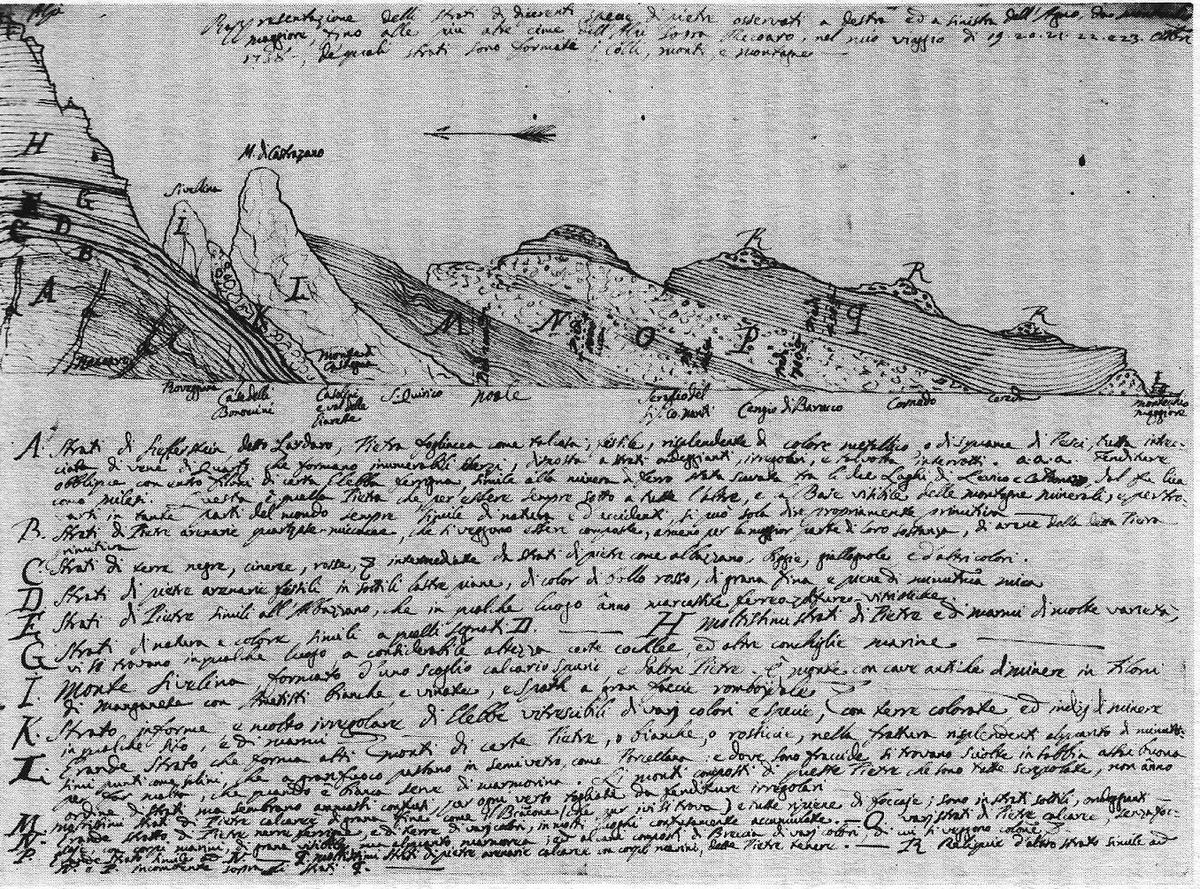
A 19th Century medallion of Giovanni Arduino. As there are no contemporary portrait of Arduino, this medallion that was made sometime before 1850 for the Venetian Pantheon in Campo Santo Stefano, Venice serves as the best option for his likeness.
| Photo Credit: Istituto Veneto di Scienze, Lettere ed Arti / Wikimedia Commons
What is stratigraphy?
A branch of geology and earth sciences, stratigraphy is a field of study that deals with the arrangement and succession of strata (layers) in the Earth. Additionally, it involves the origin, composition, and distribution of these geological strata.
In terms of geology, it is used to study rock formations and find the relative ages of rocks. From an archaeological point of view, it helps understand chronological sequence of events and human activities by studying the layers and deposits found at a site.
Lithostratigraphy (focussing on physical characteristics), biostratigraphy (using fossils), chronostratigraphy (handling time-related aspects of rock formation), magnetostratigraphy (observing Earth’s magnetic field reversals as preserved in rocks), and sequence stratigraphy (examining cyclic sedimentation patterns) are some of the important subdisciplines of stratigraphy.
Applications of stratigraphy include identifying and mapping geological formations, understanding geological history, locating mineral resources and evaluating them, dating archaeological sites and studying human activity, and understanding the evolution of life and Earth’s environment.
Who is Giovanni Arduino?
Giovanni Arduino is an Italian mining expert who turned into a geologist later in his life. He was born on October 16, 1714 in the province of Verona in the Veneto – the region north and west of Venice. By the time he moved on from this world on March 21, 1795, he had made enough contributions to geology to earn him the moniker “Father of Italian Geology” as time went by.
For nearly 20 years – through most of the 1740s and 1750s – he held various roles in the mines of Tuscany, Lombardy, and the Veneto, enabling him to become a self-taught mining engineer and surveyor. In addition to advancing his expertise in mining, the latter part of this period saw his interests in large-scale patterns in Earth’s strata and the sequences in which they were formed grow further.
Arduino’s practical knowledge and the ability to observe the structure of the mountains the way he did formed the basis of his geological studies in the years that followed. Like other geologists of the 18th Century, Arduino finished with a large collection of minerals, rocks, and fossils, some of which have found their way to museums throughout the world.
What is Arduino’s main contribution?
The 18th Century was a time when most naturalists still firmly believed that a single catastrophic event was responsible for all of Earth’s rock formations. Despite living in such a period, Arduino came to the correct conclusion that rocks must have been laid down in stages over a long period of time.
Much of Arduino’s observations and results came from studying the rocks that laid between the Alps and the plains of Venice. He divided the mountains and rocks into four basic units or “ordini” (orders) that were based on lithology, position, and internal structure.

Agno valley seen from the Piana di Valdagno hamlet. Arduino’s drawing that survives to this day is a detailed stratigraphic drawing of the rocks along this valley.
| Photo Credit:
Insetto1 / Wikimedia Commons
The first one – the one that lay beneath all other formations and also makes up much of the Alps – he called the Primary order and it consisted of granite or schist and didn’t have any stratification. On the flanks of the Primary order were the Secondary order, which was not stratified but foliated. The Secondary order had some fossils and consisted of gneisses and marbles. The third order, which he referred to as Tertiary, contained a lot of fossils. This order was clearly stratified and consisted of sandstones and limestones. The fourth and final order he didn’t name. This order was intended to include the gravels and soils of the alluvial plains of Veneto. The geologists who came after Arduino naturally followed his lead and named this fourth order as the Quaternary. This classification system of divisions laid the foundation of modern stratigraphy.
What’s this about the letters?
It was through a letter to naturalist Antonio Vallisneri Jr. dated March 30, 1759 that Arduino announced his four orders. It was Vallisneri Jr. who published Arduino’s letter, along with another earlier one, in an Italian journal in 1760. Arduino’s theory of stratigraphic subdivision was thus outlined for the first time in this publication, and is usually known as Due Lettere sopra varie osservazioni naturali (Two letters on various natural observations).
As Arduino didn’t write extensively about his four orders, and the journal in which these letters were published wasn’t that famous, his system was popularised mainly by others. This meant that his name was lost somewhere along the way, even though the system is still in use in a way similar to how he laid it out in 1759.

A detailed stratigraphic drawing of the rocks along the Valle dell’ Agno (Agno valley).
| Photo Credit:
Wikimedia Commons
The picture you can see here is the best-known graphic by Arduino himself. A detailed stratigraphic drawing of the rocks along the Valle dell’ Agno (Agno valley) near Vicenza in northern Italy, this 1758 graphic is a clear expression of Arduino’s exemplary drawing skills. Even though he makes no explicit mention of the four-order system in this drawing, it is obvious that Arduino has already started thinking about over-lying orders based on the layout of this graphic.
While Arduino published little, be it his scientific writings or his extensive correspondence with many scientists, he diligently catalogued everything. When we say everything, we literally mean it as all his papers – rough copies of letters, notes, letters, drawings – were ordered and filed according to subjects. These now serve as a rich source to examine and study his views and ideas.
Published – March 30, 2025 12:36 am IST

